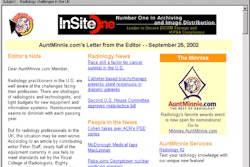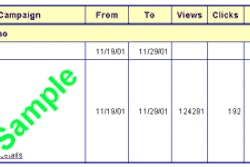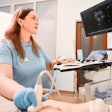NAPLES, FL - A merger of radiology groups is much like a marriage. First is the courtship, where the parties get to know one another and become comfortable. Then comes a discovery period, when each finds out about the other’s strengths and weaknesses. Lastly, a consummation of the relationship occurs where the parties join together as a single entity. Unlike marriage, however, there is no room for romance in this sort of relationship.
"The key thing in conducting a merger is to keep highly structured and organized, otherwise you’re going to waste years trying to get anywhere," observed Will Latham. Latham, president of Charlotte, NC-based Latham Consulting Group, and Joseph Serio, CEO of Nashville-based Radiology Alliance PC, discussed successful merger strategies. at the 2002 Radiology Business Management Association summit this week.
"Radiologists are looking for increased negotiating clout with hospitals and managed care programs," Latham said. "In fact, the single force driving the majority of radiology group consolidations is managed care."
Full-asset merger versus IPA
Latham stressed that a full-asset merger is vastly preferable to an independent physician association (IPA).
"Most IPAs tend to be ‘meet, greet, seat, and eat’ efforts, that have a limited impact. If you do not have collective risk sharing, you continue to be competitor groups and therefore cannot collectively collaborate in contracting with managed care," he observed.
A full-asset merger is a large undertaking for any radiology practice. It entails creating one separate professional corporation or limited liability partnership with one tax identification number. All physicians must enter into an employment agreement with the corporation, and all employees of the former practices become employees of the new entity. The physicians typically contribute all the assets, and the combined entity owns the funds and revenues created by the work of the physicians.
The full integration of two or more practices encourages a coordination of effort, provides a critical mass for new programs and services, and allows for additional coverage, as well as the addition of specialties or subspecialties to strengthen a competitive advantage.
"In addition, a merged group allows for the rational recruiting of new radiologists. We’ve seen the cost of recruiting radiologists from residency rise nearly 50% in just the past 18 months," Serio said.
The antitrust review
Latham outlined a multistep plan for a successful merger. Once the subject has been broached between practices and a commitment to move forward has been reached, an antitrust review needs to be conducted by an attorney.
"Most of antitrust legislation in the area of physician organizations is a fairly gray area. Your safety in this regard may depend more on how your group conducts business after the merger than anything else," he said.
Once this review has been completed, the groups need to appoint representatives to a merger committee and empower this committee to make decisions. Confidentiality, noncompetitive use, and "no-shop" agreements have to be signed by all parties in the merger. At this point, data gathering by the firms involved in the merger must be conducted.
After the data-gathering phase has been completed, Latham advocates a combination of merger committee meetings and retreats to review the data and discuss and resolve issues. A retreat is typically held over a 2-2 1/2-day period and enables the involved parties to connect all the issues in the merger without the stop and start inherent in weekly meetings.
A series of weekly meetings, typically no more than 6 to 10, can also be held. The time between the meetings permits the firms to reflect on the decisions made by the committee, and allows time to gather more data. Latham warned attendees that the merger committee must make decisions; otherwise the energy needed to create a unified group will dissipate.
At this point, agreements in principle and a letter of intent can be executed and merger documents can be created. These should be a merger agreement, new entity corporate documents, new entity shareholder agreements, and physician employment agreements.
Due diligence, in which each group thoroughly and completely examines the assets and liabilities of one another, is the next step in the merger process. The last step before merging is for the merger committee to develop a post-closing operational implementation plan.
Latham cautioned those in the audience interested in group mergers to avoid some pitfalls that could derail a practice consolidation.
"Whatever you do, don’t let attorneys negotiate the terms of a merger. They are professional advocates, and play a necessary role in the process, but your greatest hope for success lies in the parties involved working together to reach consensus. Also, be sure to have a planned, controlled approach to your merger. This will avoid the problem of talking but not deciding on an outcome," he advised.
The administrator as mediator
After a merger has been completed, the administrator’s work begins. Disparate business offices will need to be integrated, a senior administrator will need to be selected, front office and technologist staffing levels will need to be reviewed, and downsizing will inevitably take place. In addition, new governance groups will have to be created, processes will need revising, and workflow will change.
A significant amount of time will have to be devoted to dispelling illusions that some of the physician shareholders will have after a merger. Among these is a belief that workload will decrease and that workflow will not change. Both of these are untrue, and the administrator’s job is to continually communicate the benefits of the merger to the physician, said Serio.
"Once a merger has been completed, the radiologists will take aim at the administrator," Serio said.
The initial focus of the administrator should be on managed-care agreements. Serio advised that all entities in the merger should be rolled into the best contract and that administrators should not be timid in renegotiating their managed-care contracts. Also, all unfavorable contracts should be terminated, although the group should communicate its intent with its hospitals and key referring physicians before doing so.
The biggest challenge that Serio faced in integrating his three-practice group was one of morale. Too often, he found himself and others using the pronoun "we" when referring to a previous practice. This immediately caused an "us versus them" adversarial atmosphere.
"There are two key things an administrator can do to help ease the transition of merged groups. One is to never use the word ‘we’ when referring to your old practice. ‘We’ should only be used to refer to the merged group. The other is to build new alliances with key radiologists in each of the prior practices. Their trust in you will be communicated to those employees who trust them," Serio said.
By Jonathan S. BatchelorAuntMinnie.com staff writer
June 6, 2002
Related Reading
Marketing plan charts course to success for radiology group, June 5, 2002
RPAs may offer solution to strapped radiology practices, October 25, 2001
Regulatory compliance plans are key to avoiding legal risk, October 25, 2001
Joint ventures can help radiology groups survive APCs, July 18, 2001
Copyright © 2002 AuntMinnie.com



















